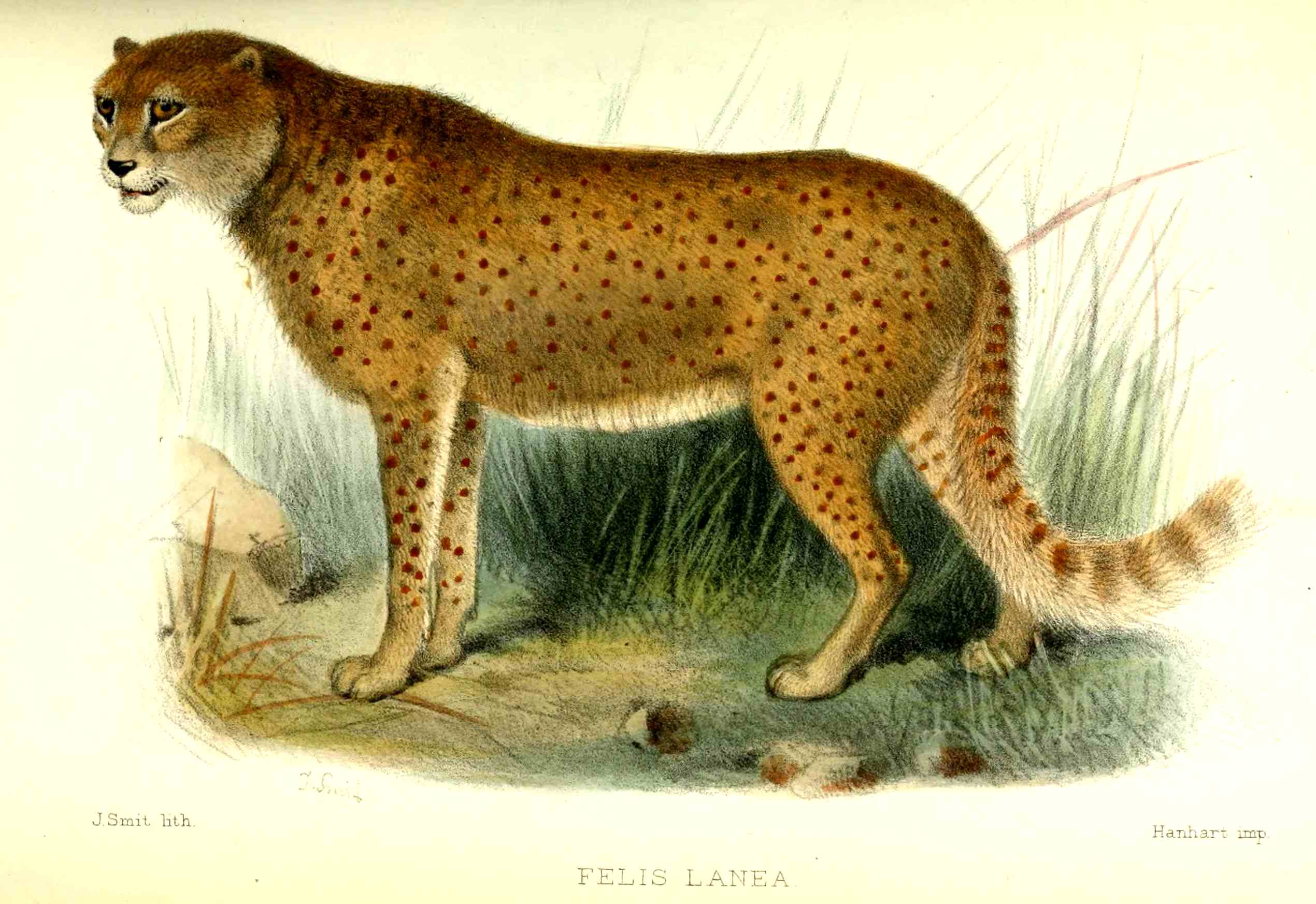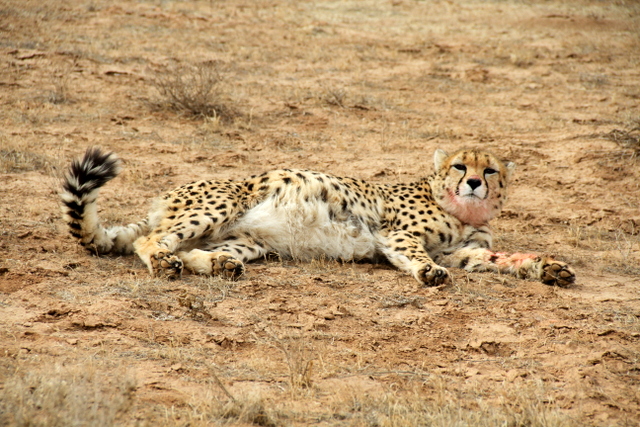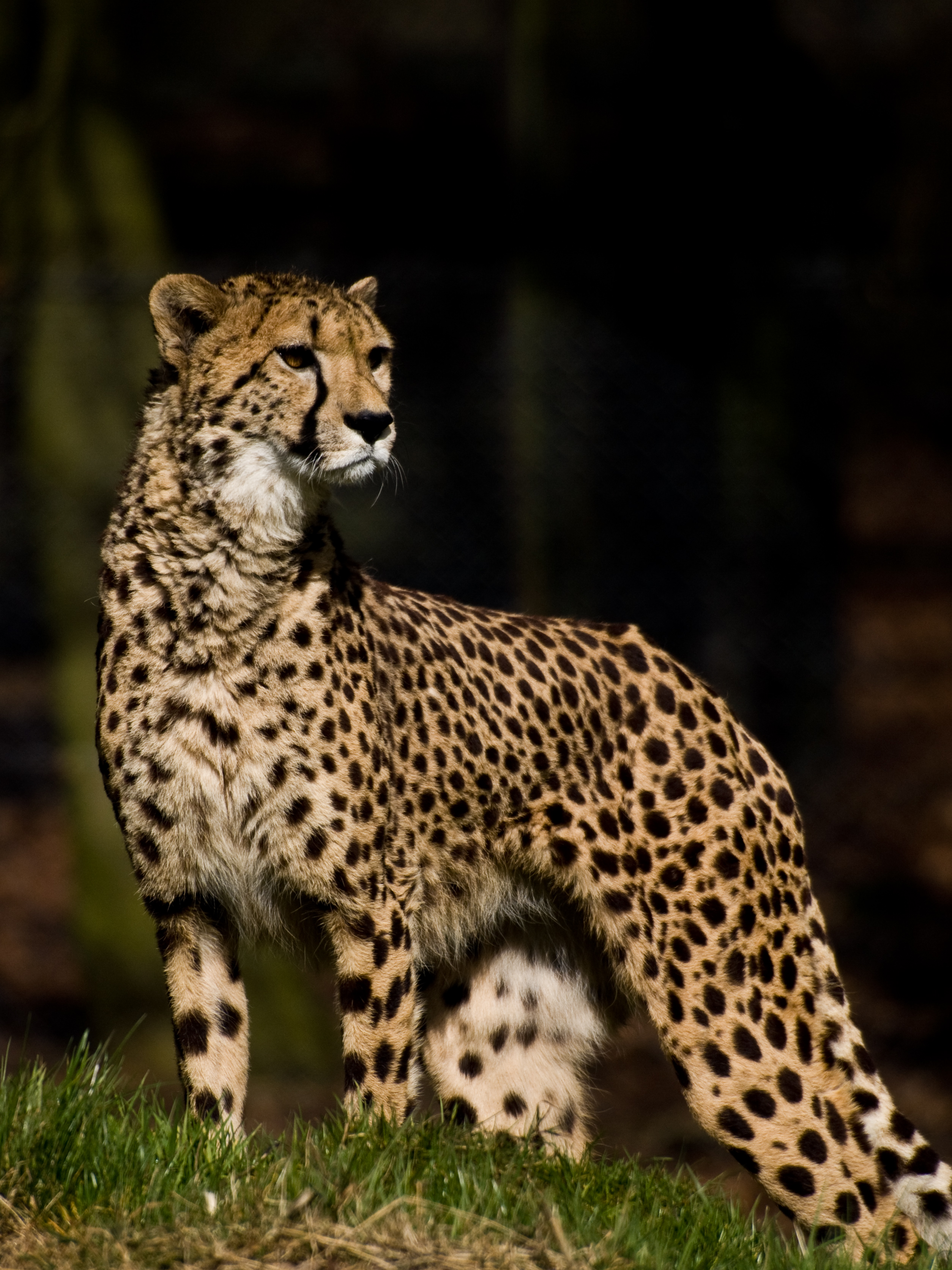|
Cheetahs
The cheetah (''Acinonyx jubatus'') is a large cat native to Africa and central Iran. It is the fastest land animal, estimated to be capable of running at with the fastest reliably recorded speeds being , and as such has evolved specialized adaptations for speed, including a light build, long thin legs and a long tail. It typically reaches at the shoulder, and the head-and-body length is between . Adults weigh between . Its head is small and rounded, with a short snout and black tear-like facial streaks. The coat is typically tawny to creamy white or pale buff and is mostly covered with evenly spaced, solid black spots. Four subspecies are recognised. The cheetah lives in three main social groups: females and their cubs, male "coalitions", and solitary males. While females lead a nomadic life searching for prey in large home ranges, males are more sedentary and instead establish much smaller territories in areas with plentiful prey and access to females. The cheetah is acti ... [...More Info...] [...Related Items...] OR: [Wikipedia] [Google] [Baidu] |
Southeast African Cheetah
The Southeast African cheetah (''Acinonyx jubatus jubatus'') is the nominate cheetah subspecies native to East and Southern Africa. The Southern African cheetah lives mainly in the lowland areas and deserts of the Kalahari, the savannahs of Okavango Delta, and the grasslands of the Transvaal region in South Africa. In Namibia, cheetahs are mostly found in farmlands. Taxonomy The Southern African cheetah was first described by German naturalist Johann Christian Daniel von Schreber in his book ''Die Säugethiere in Abbildungen nach der Natur mit Beschreibungen'' (''The Mammals illustrated as in Nature with Descriptions''), published in 1775. Schreber described the species on basis of a specimen from the Cape of Good Hope. It is therefore the nominate subspecies. Subpopulations have been called "South African cheetah" and "Namibian cheetah." Following Schreber's description, other naturalists and zoologists also described cheetah specimens from many parts of Southern and East A ... [...More Info...] [...Related Items...] OR: [Wikipedia] [Google] [Baidu] |
Asiatic Cheetah
The Asiatic cheetah (''Acinonyx jubatus venaticus'') is a critically endangered cheetah subspecies currently only surviving in Iran. It once occurred from the Arabian Peninsula and the Near East to the Caspian region, Transcaucasus, Kyzylkum Desert and northern South Asia, but was extirpated in these regions during the 20th century. The Asiatic cheetah diverged from the cheetah population in Africa between 32,000 and 67,000 years ago. The Asiatic cheetah survives in protected areas in the eastern-central arid region of Iran, where the human population density is very low. Between December 2011 and November 2013, 84 individuals were sighted in 14 different protected areas, and 82 individuals were identified from camera trap photographs. In December 2017, fewer than 50 individuals were thought to be remaining in three subpopulations that are scattered over in Iran's central plateau. As of January 2022, the Iranian Department of Environment estimates that only 12 Asiatic cheet ... [...More Info...] [...Related Items...] OR: [Wikipedia] [Google] [Baidu] |
Northeast African Cheetah
The Northeast African cheetah (''Acinonyx jubatus soemmeringii'') is a cheetah subspecies occurring in Northeast Africa. Contemporary records are known in South Sudan and Ethiopia, but population status in Eritrea, Djibouti, Somalia and Sudan is unknown. It was first described under the Taxonomy (biology), scientific name ''Cynailurus soemmeringii'' by the Austrian zoologist Leopold Fitzinger in 1855 on the basis of a specimen from Sudan’s Bayuda Desert brought to the Tiergarten Schönbrunn in Vienna. It is also known as the Sudan cheetah. In the 1970s, the cheetah population in Ethiopia, Sudan and Somalia was roughly estimated at 1,150 to 4,500 individuals. In 2007, it was estimated that 950 individuals live inside protected areas in this region; the number of individuals living outside protected areas is unknown. This subspecies is more closely related to the Southern African cheetah than to Northwest African cheetah, Saharan cheetah populations. Results of a phylogeographi ... [...More Info...] [...Related Items...] OR: [Wikipedia] [Google] [Baidu] |
Northwest African Cheetah
The Northwest African cheetah (''Acinonyx jubatus hecki''), also known as the Saharan cheetah, is a cheetah subspecies native to the Sahara and the Sahel. It is listed as Critically Endangered on the IUCN Red List. In 2008, the population was suspected to number less than 250 mature individuals. The Northwest African cheetah was described by German zoologist Max Hilzheimer in 1913 under the scientific name ''Acinonyx hecki''. Taxonomy ''Felis jubata senegalensis'' was described by Henri Marie Ducrotay de Blainville in 1843 based on a cheetah from Senegal. As this name was preoccupied, it is considered synonymous with ''A. j. hecki''. ''Acinonyx hecki'' was the scientific name proposed by Max Hilzheimer in 1913, based upon a captive cheetah in the Berlin Zoological Garden that also originated in Senegal. Characteristics The Northwest African cheetah is quite different in appearance from the other African cheetahs. Its coat is shorter and nearly white in color, with spots t ... [...More Info...] [...Related Items...] OR: [Wikipedia] [Google] [Baidu] |
Fastest Animals
This is a list of the fastest animals in the world, by types of animal. Fastest organism The fastest land animal is the cheetah. The peregrine falcon is the fastest bird, and the fastest member of the animal kingdom, with a diving speed of . Among the fastest animals in the sea is the black marlin, with uncertain and conflicting reports of recorded speeds. When drawing comparisons between different classes of animals, an alternative unit is sometimes used for organisms: ''body length per second''. On this basis the 'fastest' organism on earth, relative to its body length, is the Southern Californian mite, ''Paratarsotomus macropalpis'', which has a speed of 322 body lengths per second. The equivalent speed for a human, running as fast as this mite, would be . The speed of the ''P. macropalpis'' is far in excess of the previous record holder, the Australian tiger beetle ''Cicindela eburneola'', which is the fastest insect in the world relative to body size, with a recorded ... [...More Info...] [...Related Items...] OR: [Wikipedia] [Google] [Baidu] |
Africa
Africa is the world's second-largest and second-most populous continent, after Asia in both cases. At about 30.3 million km2 (11.7 million square miles) including adjacent islands, it covers 6% of Earth's total surface area and 20% of its land area.Sayre, April Pulley (1999), ''Africa'', Twenty-First Century Books. . With billion people as of , it accounts for about of the world's human population. Africa's population is the youngest amongst all the continents; the median age in 2012 was 19.7, when the worldwide median age was 30.4. Despite a wide range of natural resources, Africa is the least wealthy continent per capita and second-least wealthy by total wealth, behind Oceania. Scholars have attributed this to different factors including geography, climate, tribalism, colonialism, the Cold War, neocolonialism, lack of democracy, and corruption. Despite this low concentration of wealth, recent economic expansion and the large and young population make Afr ... [...More Info...] [...Related Items...] OR: [Wikipedia] [Google] [Baidu] |
Springbok
The springbok (''Antidorcas marsupialis'') is a medium-sized antelope found mainly in south and southwest Africa. The sole member of the genus ''Antidorcas'', this bovid was first described by the German zoologist Eberhard August Wilhelm von Zimmermann in 1780. Three subspecies are identified. A slender, long-legged antelope, the springbok reaches at the shoulder and weighs between . Both sexes have a pair of black, long horns that curve backwards. The springbok is characterised by a white face, a dark stripe running from the eyes to the mouth, a light-brown coat marked by a reddish-brown stripe that runs from the upper fore leg to the buttocks across the flanks like the Thomson's gazelle, and a white rump flap. Active mainly at dawn and dusk, springbok form harems (mixed-sex herds). In earlier times, springbok of the Kalahari desert and Karoo migrated in large numbers across the countryside, a practice known as ''trekbokking''. A feature, peculiar but not unique, to t ... [...More Info...] [...Related Items...] OR: [Wikipedia] [Google] [Baidu] |
Impala
The impala or rooibok (''Aepyceros melampus'') is a medium-sized antelope found in eastern and southern Africa. The only extant member of the genus '' Aepyceros'' and tribe Aepycerotini, it was first described to European audiences by German zoologist Hinrich Lichtenstein in 1812. Two subspecies are recognised—the common impala, and the larger and darker black-faced impala. The impala reaches at the shoulder and weighs . It features a glossy, reddish brown coat. The male's slender, lyre-shaped horns are long. Active mainly during the day, the impala may be gregarious or territorial depending upon the climate and geography. Three distinct social groups can be observed: the territorial males, bachelor herds and female herds. The impala is known for two characteristic leaps that constitute an anti-predator strategy. Browsers as well as grazers, impala feed on monocots, dicots, forbs, fruits and acacia pods (whenever available). An annual, three-week-long rut takes place ... [...More Info...] [...Related Items...] OR: [Wikipedia] [Google] [Baidu] |
Felidae
Felidae () is the family of mammals in the order Carnivora colloquially referred to as cats, and constitutes a clade. A member of this family is also called a felid (). The term "cat" refers both to felids in general and specifically to the domestic cat (''Felis catus''). Felidae species exhibit the most diverse fur pattern of all terrestrial carnivores. Cats have retractile claws, slender muscular bodies and strong flexible forelimbs. Their teeth and facial muscles allow for a powerful bite. They are all obligate carnivores, and most are solitary predators ambushing or stalking their prey. Wild cats occur in Africa, Europe, Asia and the Americas. Some wild cat species are adapted to forest habitats, some to arid environments, and a few also to wetlands and mountainous terrain. Their activity patterns range from nocturnal and crepuscular to diurnal, depending on their preferred prey species. Reginald Innes Pocock divided the extant Felidae into three subfamilies: the P ... [...More Info...] [...Related Items...] OR: [Wikipedia] [Google] [Baidu] |
Ungulate
Ungulates ( ) are members of the diverse clade Ungulata which primarily consists of large mammals with hooves. These include odd-toed ungulates such as horses, rhinoceroses, and tapirs; and even-toed ungulates such as cattle, pigs, giraffes, camels, sheep, deer, and hippopotamuses. Cetaceans such as whales, dolphins, and porpoises are also classified as even-toed ungulates, although they do not have hooves. Most terrestrial ungulates use the hoofed tips of their toes to support their body weight while standing or moving. The term means, roughly, "being hoofed" or "hoofed animal". As a descriptive term, "ungulate" normally excludes cetaceans as they do not possess most of the typical morphological characteristics of other ungulates, but recent discoveries indicate that they were also descended from early artiodactyls. Ungulates are typically herbivorous and many employ specialized gut bacteria to allow them to digest cellulose. Some modern species, such as pigs, are omnivorous, ... [...More Info...] [...Related Items...] OR: [Wikipedia] [Google] [Baidu] |
Territory (animal)
In ethology, territory is the sociographical area that an animal consistently defends against conspecific competition (or, occasionally, against animals of other species) using agonistic behaviors or (less commonly) real physical aggression. Animals that actively defend territories in this way are referred to as being territorial or displaying territorialism. Territoriality is only shown by a minority of species. More commonly, an individual or a group of animals occupies an area that it habitually uses but does not necessarily defend; this is called its home range. The home ranges of different groups of animals often overlap, and in these overlap areas the groups tend to avoid each other rather than seeking to confront and expel each other. Within the home range there may be a ''core area'' that no other individual group uses, but, again, this is as a result of avoidance. Function The ultimate function of animals inhabiting and defending a territory is to increase the indi ... [...More Info...] [...Related Items...] OR: [Wikipedia] [Google] [Baidu] |
Home Range
A home range is the area in which an animal lives and moves on a periodic basis. It is related to the concept of an animal's territory which is the area that is actively defended. The concept of a home range was introduced by W. H. Burt in 1943. He drew maps showing where the animal had been observed at different times. An associated concept is the utilization distribution which examines where the animal is likely to be at any given time. Data for mapping a home range used to be gathered by careful observation, but nowadays, the animal is fitted with a transmission collar or similar GPS device. The simplest way of measuring the home range is to construct the smallest possible convex polygon around the data but this tends to overestimate the range. The best known methods for constructing utilization distributions are the so-called bivariate Gaussian or normal distribution kernel density methods. More recently, nonparametric methods such as the Burgman and Fox's alpha-hull and Getz a ... [...More Info...] [...Related Items...] OR: [Wikipedia] [Google] [Baidu] |




_in_the_road.jpg)

